Thank you, Admiral Padgett for the introduction and thank you for the update on “Big Al” Konetzni. Certainly anybody at least my age, when you hear that name, it
brings back a flood of memories probably across a spectrum of ports and liberty stories.
But I will tell you, the then-commander Konetzni is the reason I’m in the Submarine Force. At the Naval Academy he brought Midshipmen Merz into the Submarine Force. So we hope he is okay and I’ll look forward to future updates.
It is good to be back in the D.C. area. I’m actually that guy that likes D.C. My wife is from here, and after two years in Japan it is nice to get back to America. Thanks for having me.
You heard it stated a couple of times over the last couple of days, that I am fresh from command at Task Four 54 in Bahrain and Task Force 74 in Yokosuka, Japan. We talked about numbers and capacity, but to put that into the real context, between those two task forces they own the chunk of ocean from the Suez Canal to the international dateline, going the other way around. That’s 8,700 nautical miles, so I certainly have a capacity problem.
At last count, it included somewhere north of 220 what we call credible submarines, ones that can actually go to sea, submerge, and operate. China, Russia and North Korea are all included into the numbers of ballistic missile submarines, and they’re marching right along. That overall number is growing at a concerning rate.
So with that thought going out to those jobs, I was determined to run our submarines exceedingly hard. I burned a lot of EFPH (Effective Full Power Hours). For the non-nukes in the room, that’s the gas tank we use to measure our reactor plants.
I really wanted to find the limits of our boats. And in some cases, Admiral Roegge (Commander, Submarine Force, U.S. Pacific Fleet) and Admiral Tofalo (Commander, Submarine Forces) will attest, I did find those limits, aggressively. In one case we actually had to pull back a little bit. I was kind of outpacing our training, which is kind of hard to do, and I’ll get to that in a minute.
But a couple of things I learned in that job is that our boats really are the best in the world. You heard Admiral Caldwell yesterday mention that the USS CITY OF CORPUS CHRISTI, the USS HOUSTON, and the USS ALBUQUERQUE are all in the inactivation process and we’re converting LA JOLLA to a moored training ship. So the real story there is what they were doing just before they entered inactivation and into the conversion.
They were out there deployed with me on the front lines in WESTPAC (Western Pacific) to the very last day of their operational lives. That is a testament to the platforms, the shipbuilders, those that modernize, the Admiral Johnsons of the world, the Admiral Jabaleys of the world. We keep them modern and keep them running and they do the same missions that every other submarine does until the day we retire them. It’s just a colossal report card, if that’s the term we’re using right now.
But I also learned, and without a doubt, our most asymmetric advantage out there are our crews, the COs (Commanding Officers), the Wardrooms and the band of merry men and women that fill out the teams behind them. They run hard, they do well, and their proficiency over other navies is amazing. And here’s the thing about proficiency, you can’t steal it. You can’t bottle it. You can’t fake it. You have to actually go out there and do it and you have to do it every day. That’s what our teams do, and I really do believe it’s our biggest advantage.
Everyone in this room that’s a submariner supporting the Submarine Force shares credit for how well these crews operate today, because they’re built on your shoulders. As Admiral Padgett said yesterday, as hard as it is to swallow sometimes, they are not just a little better than we were, they’re exceedingly better as these new generations of multi-taskers come up. But this doesn’t happen by accident, and as the new director, and with that as backdrop, I would like to walk you through the lens through which I look at our investments.
To that end, I’ll review our guidance quickly. I’ll explain what that guidance means to us as an undersea force, and then distill it down into our war fighting missions, and then provide some insight into our program.
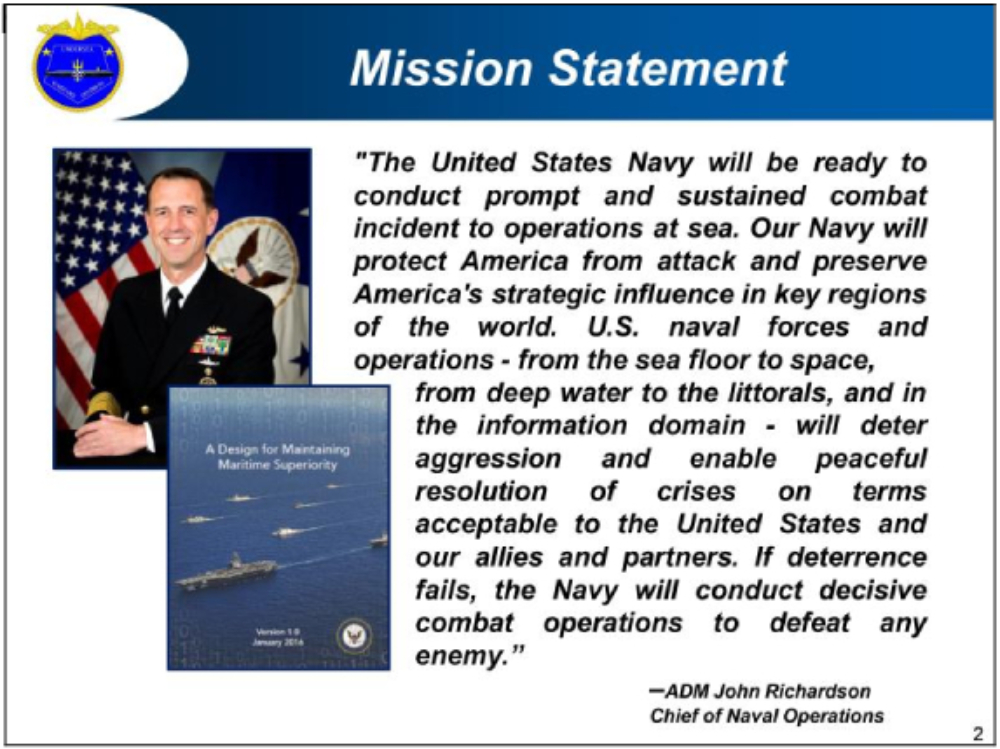
This is the CNO’s (Chief of Naval Operations, ADM Richard- son’s) guidance, nothing new, just pointing it out at the seminar, the design for maintaining undersea superiority. But there is actually guidance left of this guidance, and it includes our national maritime strategy and it includes U.S. Code. And it directs us, the U.S. Navy, to be able to conduct combined sustained combat operations far forward. But it also further specifically directs the undersea forces to leverage our unique advantages of the undersea domain to bring the nation an advantage and a capability that otherwise it would not have: cross-domain, covertly, both connected and independently.
So this is structured under the CNO’s design for maintaining maritime superiority. When this design hit the street, I was very happy to see that maintain was in the title, because I really do think we’re a superior navy. The rub is staying there.
Over the last days the design has been reviewed, it has been explained. We heard the CNO say it in his own words last night and we watched his video yesterday. So there’s no need for me to go through all the colors at this point, but I will say—and I’m not grading the CNO’s homework by any means here—but I really do believe it’s good guidance. It’s executable guidance, and it’s fundamental for us going forward.
He is breaking us out of old-think. For those that have operat- ed at-sea with crews, especially in the nuclear Navy, we have some pretty powerful tools out there to change the behavior of our teams. Changing that culture takes a much longer time and is a much higher task, and that is what the CNO is asking us to do.
It creates friction, friction creates heat and energy, and energy is what we live on. So I think this is a great start. It’s going to take some time and I’m glad he got it out so early in his tour.
Although I work for a variety of people and I get to call my- self the Director Undersea Warfare, a very lofty title, I do have some bosses. The Commander of the of Submarine Force, Vice Admiral Tofalo, I would call him the real director of undersea warfare. And then he might call Admiral Caldwell the supreme allied commander of the director of undersea warfare, as we go. So I am looking forward to all the great guidance and directorship that I’m likely going to get with these programs.
Vice Admiral Tofalo went through his guidance yesterday and it’s exceedingly aligned with the CNO. It’s a good survival tactic to stay aligned with the CNO. It ties to and cuts across all the gold banners of the CNO.
But here’s the thing, Admiral Tofalo in concert with Admiral Roegge, pretty much had this thing written before the design came out. So when the design came out they were able to make some minor force changes just to make sure the terminology and the words aligned. But he was able to put that thing out almost immediately after the CNO’s design.
If you haven’t read Admiral Tofalo’s guidance, it’s well thought out. It’s specific. It’s not like he did this overnight. That is because the CNO is one of us and that’s how aligned our DNA tends to be.
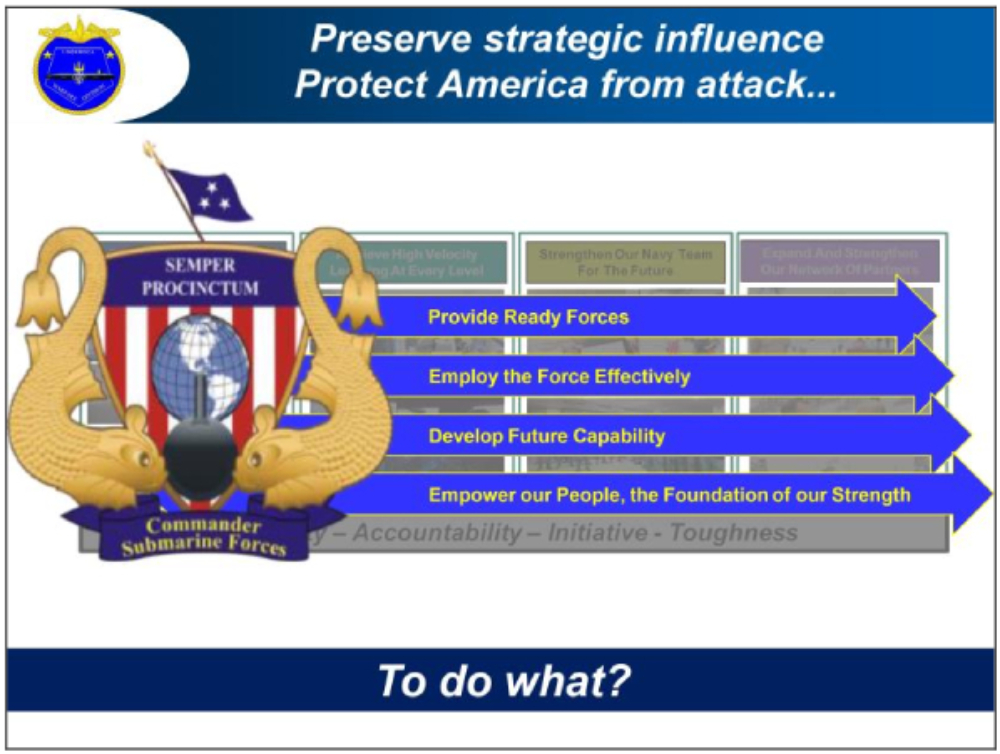
So we provide all this guidance to do what? That’s the banner across the bottom here. This is what I’m going to walk you through and hopefully understand that lens I spoke about when I started my talk here.
To do what has been put out in our strategy, it is to deploy combat forces. But there is more to it than that. Our maritime strategy for the last couple of centuries, both real and implied, is to first and above all else keep everything an away game. Keep the fight a home game for the bad guy.
We’ve done that effectively and you really do have to go back to maybe the 1800s, the War of 1812, when you can find the last time we’ve actually had a force-on-force naval battle within sight of our shores. I don’t see this strategy changing any time soon. As a matter of fact, if you go back even further the reason we built those first legendary six frigates was to take on the pirates in the Mediterranean that were interjecting with our merchant traffic. So we’re all about deploying overseas. We’ve literally been doing it since day one.
To do that, we need to be far forward. It’s why we have nucle- ar-powered attack submarines and nuclear-powered ballistic missile submarines. When you distill it down, we have two fundamental missions. If this is the first you’ve heard this, great, but this is the way I’m going to be talking about our investments while I’m the Director.
The first is strategic deterrence. We’ve been doing this day-in and day-out for 70 years. We’re not coming off that, and I’m going to talk a little bit more about the OHIO Replacement here in just a second.
The next is this very new term called theater undersea warfare. In the largest terms, it’s kind of a collection of everything else we do. But the reason I’m rolling this up under this term—this term was initiated under Vice Admiral Connor and we’ve carried it through. You’ll start seeing it in our publications as we continue to evolve.
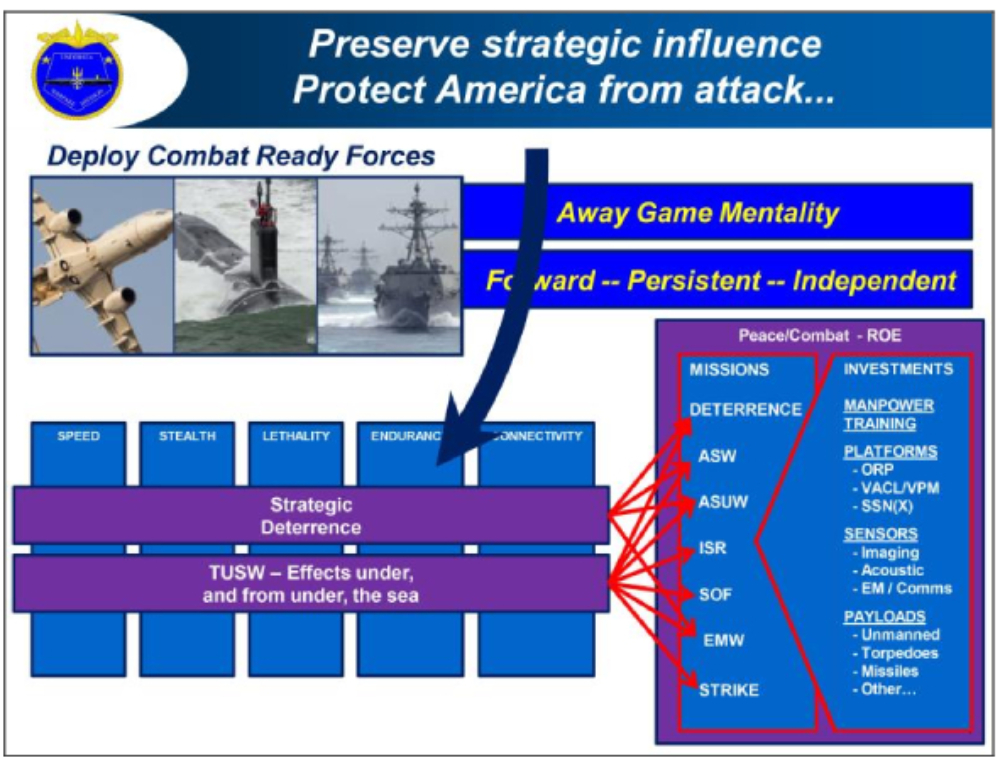
But it involves things like Theater ASW (anti-submarine warfare), anti-surface warfare, strike and special forces operations. We do all that stuff for a purpose, and we do it deliberately, to do things we do better than anybody else. It is what the Fleet depends on us to do – “attrite the enemy and to provide access.”
It’s unlikely the Submarine Forces or the undersea forces writ large are going to win a major battle or a war. Our job is to knock down the door, provide access and enable those that will. It’s a huge team effort.
If I build this out further, clearly what we do is based on our most enduring characteristics of speed, stealth, lethality, endurance, and connectivity. Where I just came from speed and lethality are everything. When you have an AOR the size of the one we’re managing out there, your speed is a force multiplier. You can literally be almost in two places at one time with enough speed and enough firepower to carry out the mission when you get there.
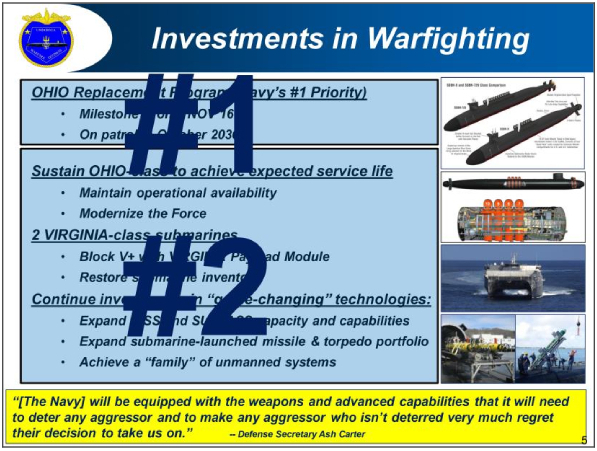
As we look ahead to the SSN(X), or the next generation SSN, or whatever the next attack platform is going to be, from my perspective speed is going to be an entering argument and we’ll diversify from there. From these two missions I should be able to map them to every sub mission that we do, and I can, and beyond that, mapping it to the investments. As long as I can do that, we will continue to provide to all our wonderful bubbleheads around the world what they need for their own personal design for maintaining maritime superiority.
In my design for maintaining a dependable program, I think that connective tissue is hugely important for building a sellable program and actually delivering the capability we need in a very fiscally constrained environment. So in that last build-out there, if you didn’t notice it, one of the luxuries of what we do is that peacetime and wartime really are not a whole lot different to us. The missions are virtually the same. It’s just a matter of the rules of engagement behind it. So we are always postured to carry out the nation’s business along whatever spectrum we’re required by higher guidance.
So real quickly as a summary here, or an overview— unfortunately we’re not quite done—but ORP, our top priority, you’ve heard it said many times here, it does leverage what we’ve been doing with the VIRGINIA-class that goes beyond just the platform or just the module. It goes to the missiles. It’s a very complex, very large program, bringing in new electric drive technology.
It’s going to be a little bit smaller tube-wise. It’s coordination with the UK. There’s a lot of moving parts, a lot of directions that we have to manage as we’re building this.
But we also have to sustain the OHIO-class while we’re building the OHIO Replacement. That’s no small task either. We have extended the class out to 42 years. That is going to generate some surprises along the way.
We have not hit 42 years on any of these boats yet, so we are still just getting into what this is going to entail. But it’s all about sustaining our presence at-sea, that survivable nuclear deterrent, with the current class while we’re bringing on the new class. This is a very closely linked program as we try to get that first Ohio Replacement on patrol, in the lineup, by the fall of 2030.
Then also in the background is the VIRGINIA-class. We are building exactly one attack submarine right now. It is the heavy lifter that’s going to replace the Los Angeles-class. So far, it has done extremely well.
Then we have the upcoming investments, and I’ll just say a couple of words about the payloads and the unmanned vehicles in a couple of slides. But I did want to mention and circle back to what Admiral Tofalo said yesterday about the TANG enterprise. It started in the undersea community. We picked that acronym specifically for its historical context to USS TANG, and we were just happy to be able to fit the right words into that acronym, the Tactical Advancements for the Next Generation.
But you’ve got to understand where that came from, and that kind of process is directly in line with what the CNO is trying to get us to do. It’s a revolutionary approach to idea generation, not an evolutionary approach. For all of us that came into the Submarine Force, we were all deprogrammed and put on the conveyor belt of how to learn our sensors and our weapons. This is a generational jump to try to figure out how to get these extremely connected youth that are warriors, to help design a system that is more suited to their innate capabilities coming into the Navy.
So when we did this back during my DEVRON 12 days, I rode a lot of submarines and I got a lot of feedback, and it was all pretty negative feedback about the combat systems, a lot of frustration. Dennis McKelvey was with me there when we did this. I said, alright, to hell with it, let them design it.
I wasn’t particularly serious, but the within a week Johns Hopkins is knocking on my door saying, funny you should say that. They’d been pitching this idea of a seminar with a younger generation, professionally moderated by a team up in Palo Alto called IDEO, which was called the design thinking enterprise, as a way to brainstorm down into some executable ideas. And because the Navy Yard and IWS 5 (NAVSEA Integrated Warfare Systems) already had that conveyor belt of the APB (Advanced Processor Build) cycle mature, turning product within two years, we had everything in place to actually put product out that these guys came up with. A lot of it is already out in the fleet.
I really think that’s the high velocity learning at a very high level that the CNO was getting at. That’s our small piece and we’re starting to crack that open. Expect to see more of that.
When you wrap all this up, we’re the number one and two priorities in the CNO’s guidance. No pressure there. That’s good news and it’s a little bit scary for a new director coming in. We’re going to get a lot of visibility, a lot of money involved here.
But I will tell you from where I came from it is absolutely critical that we do not come off the pace of any of these programs. So much relies on our ability to perform on-call. We are the 911 force out in the world. And really, if we’re doing our job right, no one can touch us. We’ve got to maintain that advantage.
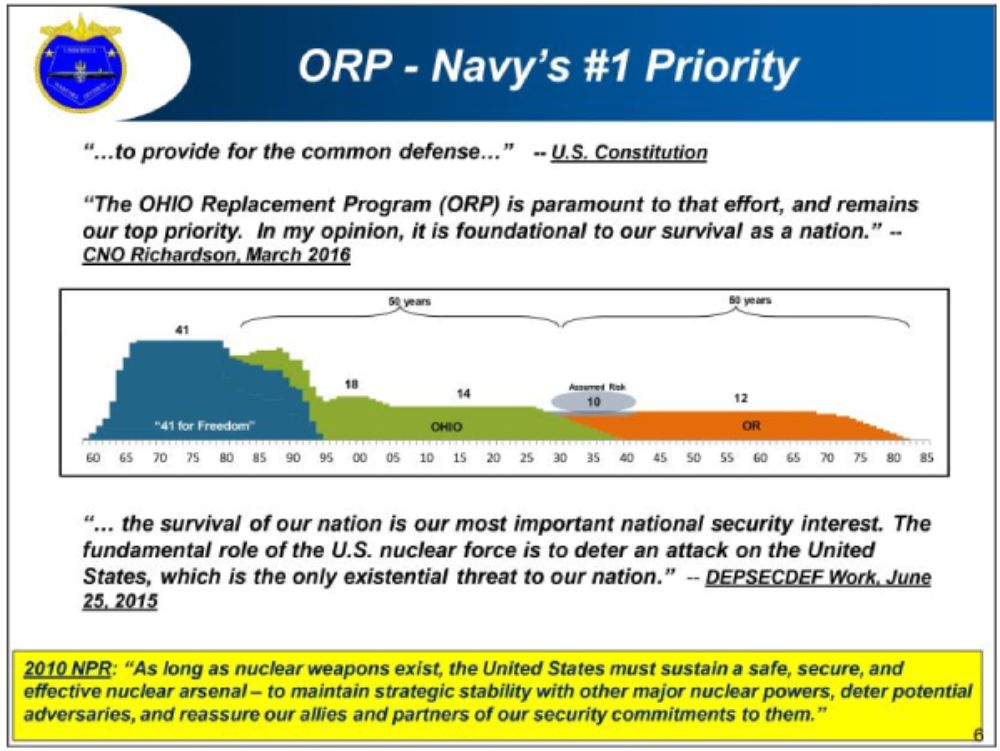
OHIO Replacement, and these sound bites are important. They are backed by a whole lot of math and a whole lot of study. But we do this every other generation and it consistently hovers around one percent of the defense budget. From our perspective, it is infinitely affordable for what we have to do and what relies on these platforms.
This deterrence must prevail. There’s a great Sun Tzu quote that says, “To win 100 victories in 100 battles, that’s not the acme of skill. To subdue the enemy without fighting at all is the acme of skill,” and that’s what this deterrence does.
This program will be with us into the 2080s. The requirement is 12 boats. It is 12 boats. Say it with me, “12 boats.”
CHORUS: “Twelve boats.”
ADM. MERZ: No less. It is based on survivability and it’s based on warheads. As a matter of fact, given these quotes from the leadership, I’m actually surprised why I don’t get more questions on why only 12? Why not 14 like we have today, or more? Do you, admiral, understand the consequences of failing in this mission? I assure you, I do.
So we will not come off our requirement. The requirement is based on a whole lot of math, and we love math. As I always tell my kids, math never fails you.
But it is about sizing the force for survivability. It’s not about warheads. It’s about establishing and maintaining an insurmounta- ble problem for the adversary, and we’re on track to do that.
Just recently, as I move to the next slide here, I did my first visit to Quonset Point. If you haven’t been up there, it will make you feel good about being an American. You are talking about some major pieces of metal moving around at a high rate. It’s really impressive, the industrial capacity, what’s in play right now. So as I move into the overall Submarine Force structure, our requirement remains at 48 SSNs, and we’re above that require- ment now. You guys have all seen this, I’m pretty sure. But come fiscal year 2025 is when we get below that 48, and with a low point of 41 in fiscal year 2029. The demand signal continues to rise, and that’s just a reflection of the increasing threat around the world.
The trough—and you can slice this many different ways—but when you count up all the attack submarine years, it’s 51 SSN- years that are unavailable. I think you’ve heard that number before. And it lasts for about 16 years.
I really don’t have many levers to pull to lessen that trough. One of the levers we do pursue persistently is to continue that two VIRGINIA-class per year build for the life of the program. Just one more ship makes a difference, and we’re going after that ship in fiscal year 2021 as we try to round out the trough.
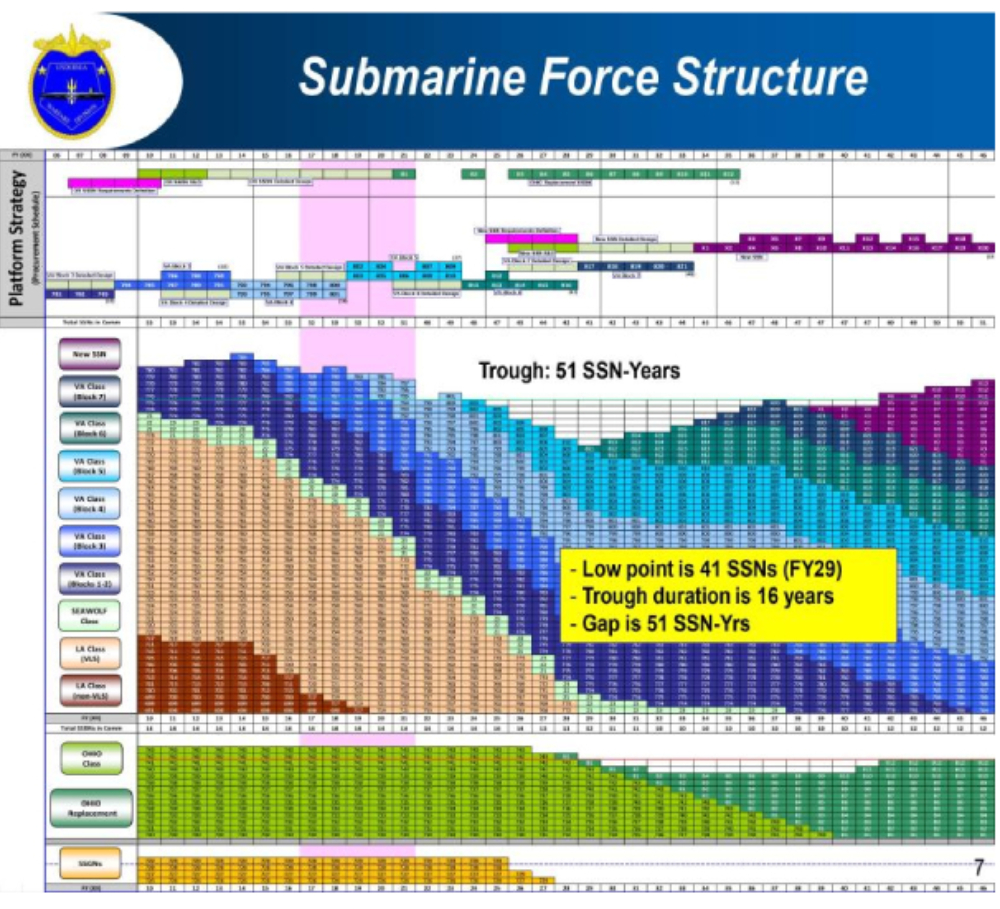
Fast forward, this is a tough build to see because it’s not big, but it just adds that extra ship in fiscal year 2021 to the trough. But what that does, it shortens that trough from 51 years to 36 years, so it’s a pretty significant drop. And it shortens the length of the trough to 11 years from 16 years. So when you look as it varies under the curve, that may not be immediately obvious, but it just gives an example how just one platform when you’re adding to a requirement that low, makes a huge percentage difference in what we’re trying to achieve.
We can get there. I mean, the engineering efficiencies are in place. We continue to deliver these submarines on-time and under budget. As a matter of fact, USS ILLINOIS, which was delivered in August, is the ninth in a row delivered ahead of schedule.
But it is challenging and it’s going to get more challenging for our shipyards. I really appreciated Admiral Jabaley’s analogy to the tonnage. Actually it was not an analogy, it’s tonnage.
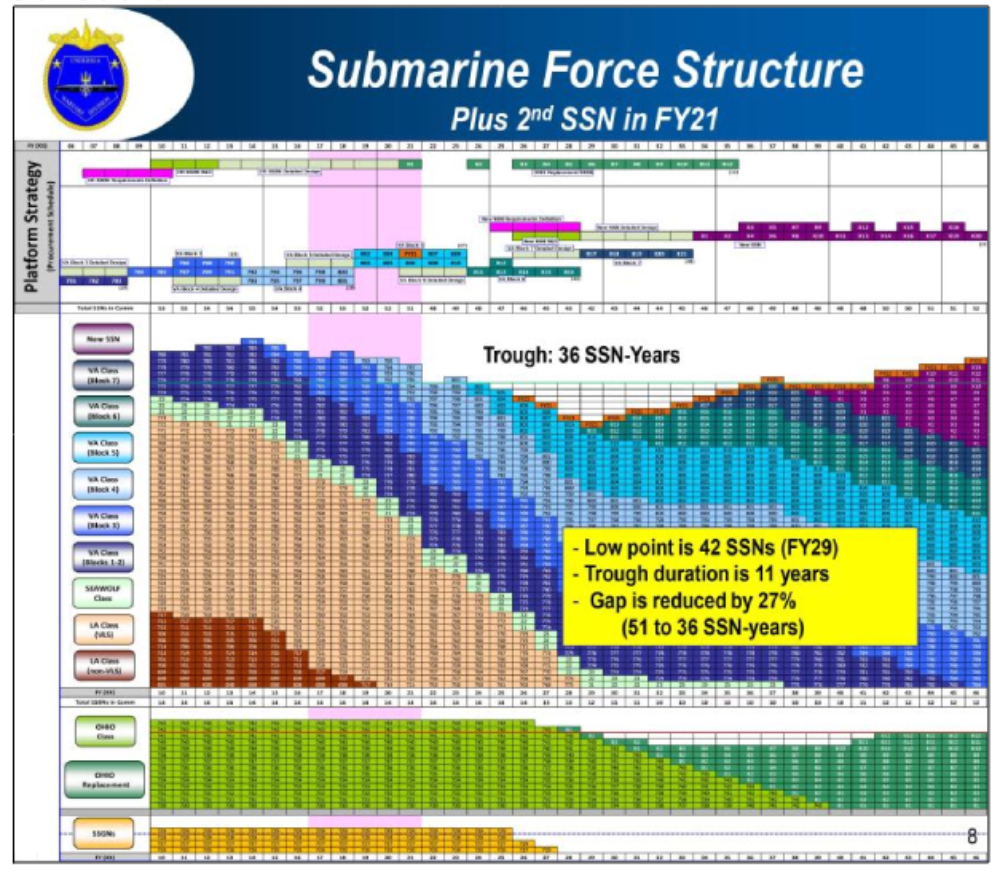
It’s what we’re looking for into the 2020s when we’re build- ing potentially two Virginia-class submarines, the OHIO Replacement and the VIRGINIA Payload Module all at the same time. We are relying on the industrial might of our country to ramp up and meet that demand. This is Freedom Forge all over again. We’ve never seen anything like it.
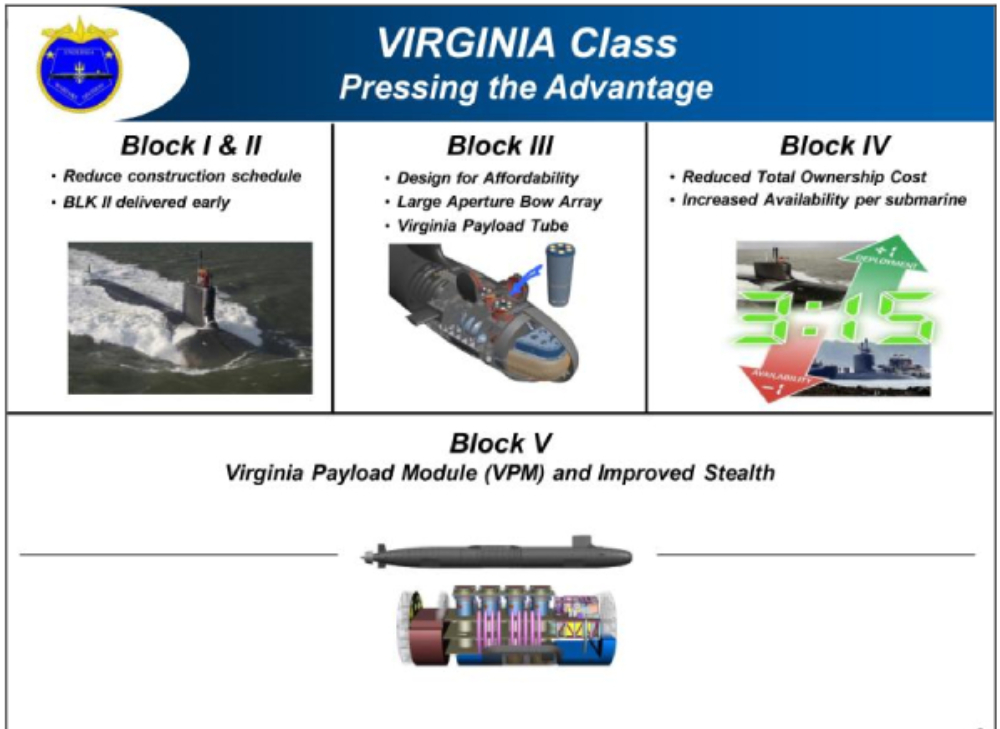
Virginia-class, it’s humming right along. The VIRGINIA Payload Module is in Block 5. We continue to improve and find efficiencies. Block 3 was probably the biggest structural change we did of going to the VIRGINIA Payload Tubes, a much simpler design, much lower maintenance costs, and a much more deliberate build cycle. We’ll continue that through Block 4 and Block 5. We think we’re in pretty good shape with the first one coming in fiscal year 2019, and the second ship in fiscal year 2020. So we’re on track to continue the evolution of a ship that was originally designed to be entirely adaptable, and we’re sticking to that.
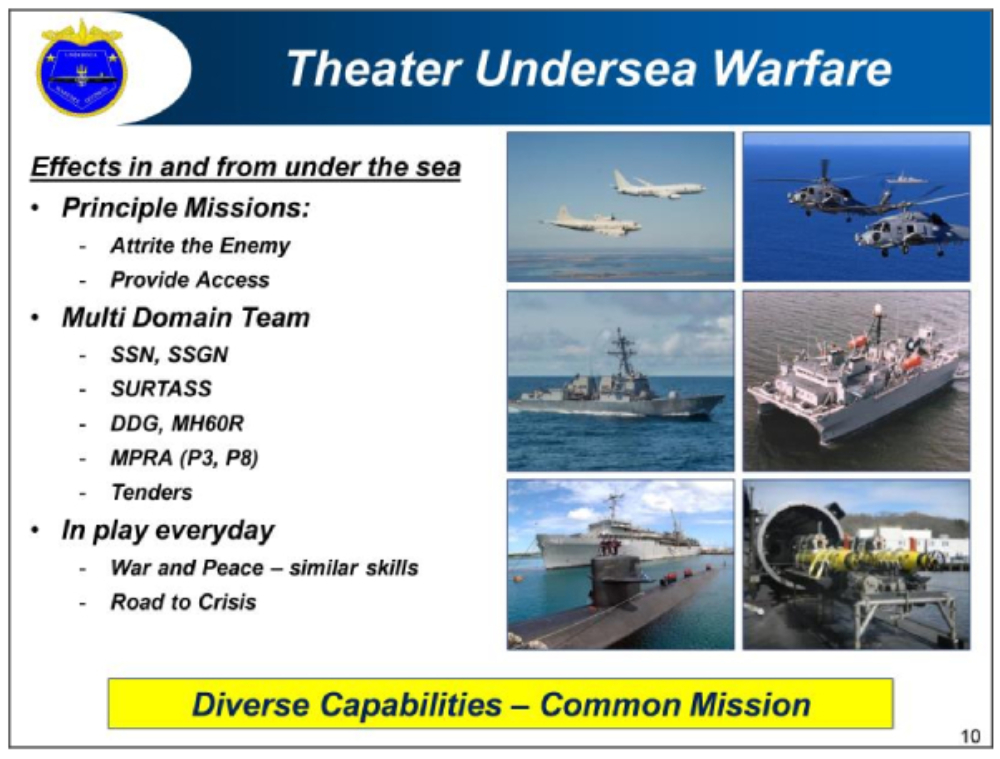
This is what I really want to talk about, this whole theater undersea warfare thing. Before I forget everything I did out there for the last year and a half, I want to get it out to this team on how complex and how important this mission really is, and how it drives the investments I already talked about. One of the reasons I drove the boats so hard in WESTPAC was anxiety.
I had this very uneasy feeling that we were always on the road to crisis out there, and you’d better be ready to perform. You call that, from the nuclear side, healthy paranoia, which is one of my favorite tenets in our program. But you need to be ready to respond, and it’s clear the undersea forces, as I said before, will be the first responders.
Really, it does transcend to our peacetime missions. How efficiently we do our peacetime mission translates directly on how effective we’re going to be in war. But also, I felt this very strong desire to continue to build the depth of the bench of our Ward- rooms, by exposing them to as many of the harsh environments, as many of the challenging missions, as I could.
Not only do they enjoy being challenged, these are your return deployers. They’re going to be your department heads, your XOs and your commanding officers. There’s a lot going on in the world. And I’ll tell you there’s a fight probably coming and I want these kids to be ready for it.
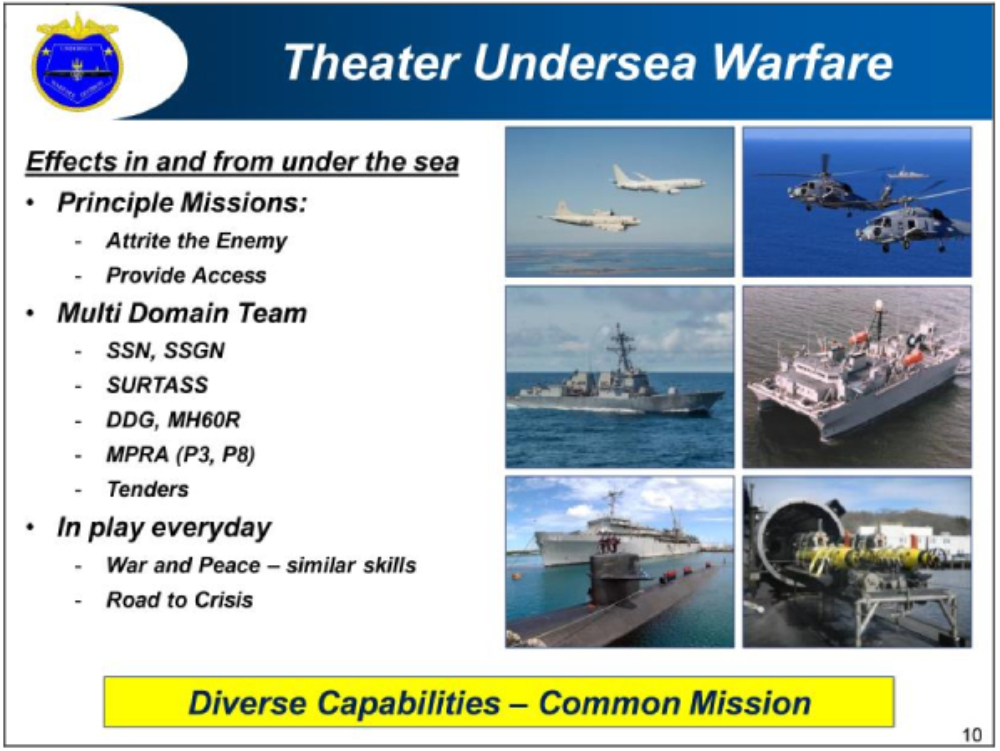
Working closely with the other task forces I loosely represent there on that slide, our role is to attrite and attrite quickly in support of that larger battle force. But it really takes a team of warriors to do that, when I talk about the distances and volume of ocean I’m talking about in prosecution. And getting the right search platforms and the right tactical platforms on task. We’ve become so integrated, particularly in 5th and 7th Fleet, that over 50 times in 2016, my first half of 2016 before I left, we as the undersea warfare commander took tactical control of destroyers,
50 different times, where they were given over to us in a prosecution role. So this is the undersea guy running the destroyers around, and it was a lot of fun, but it also tells you how integrated and broad we have to be.
But we also fundamentally changed our mentality out there from a defensive posture to an offensive posture. That was an order of magnitude improvement in our efficiency and carrying out our missions in the Western Pacific. I will tell you I think there’s still too much defensive thinking out there. It’s not a healthy thought process if you’re a numerically inferior force, historically a losing proposition.
I think we’ve gotten a little lazy in peacetime, that we can cover more area when we take a defensive posture. I would rather take an offensive posture and shrink that area down. It has proven to be effective and we’ve learned this lesson over and over again. So I would ask you in industry to think offensively when you come up with your good ideas.
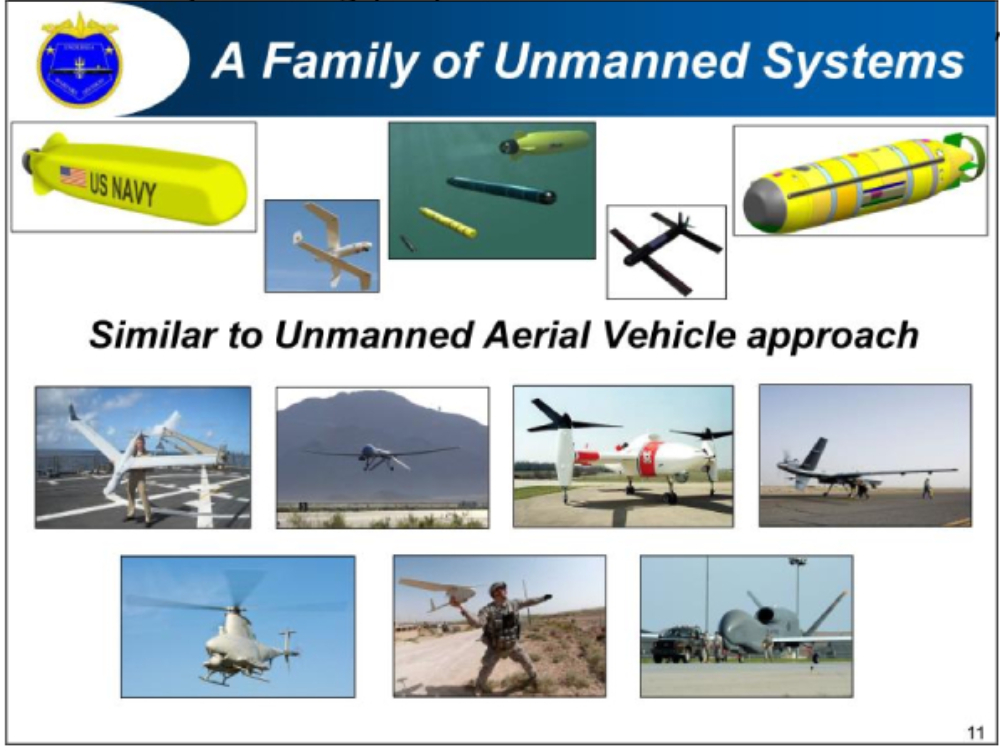
Moving along here, unmanned systems. I think there’s real gold in unmanned systems. I’ll give you my quick sound bites and thoughts on this area of investment.
Our area, our domain under the sea, is hard. This is not the same as building unmanned air systems. As a matter of fact, I would tell you I probably get more use out of the unmanned air systems right now off of submarines, than we do the unmanned underwater systems. It’s a reflection of how challenging it is.
For one, we are truly unmanned. When you send these vehi- cles out, they work autonomously until they come back, or they don’t come back. It’s not a man in the loop in Nevada driving it forward. There is no man in the loop. So we kind of define unmanned across the spectrum.
It’s a harsh environment that just gets harsher the longer we’re in it. Technology is hard, and it’s hard to get it out to sea. I spoke at the unmanned conference in Pentagon City earlier this week. We related to them that we are making progress, but I’m tired of waiting.
Give me what you have. I will take it to sea. I will give you feedback, and you continue to develop and evolve, and I will take that to sea and give you more feedback.
I have a spectrum of missions, from the dull, dirty, dangerous, all the way up to the Starship ENTERPRISE. I have the Starship ENTERPRISE, it’s the VIRGINIA-class. I hope unmanned systems get there eventually, but until then give me what you have. I can plug holes that unburden the SSN force.
So we’re very excited with the technology. I just co-signed the MOA (Memorandum of Agreement) with Admiral Tofalo for our undersea vehicles and I’m very excited to get those things out there and get them in the fleet and try out how they work. I think we need to take advantage of the fact that they’re unmanned. We don’t have to be as careful with them. There is rarely a case where humans are in danger when we’re dealing with unmanned systems. To give you an example, in the mineworker community we fielded the Mark 18 Mod 2. We just gave them to the sailors, the developers went with them, and put them in the Middle East working and doing real missions. We think we pretty much skipped a whole generation of testing, evaluation and develop- ment, and the vehicles worked better than anticipated. So with that thought process, I am very committed to the unmanned systems, but I want to get them out there. I want to kick them over the side and start using them.
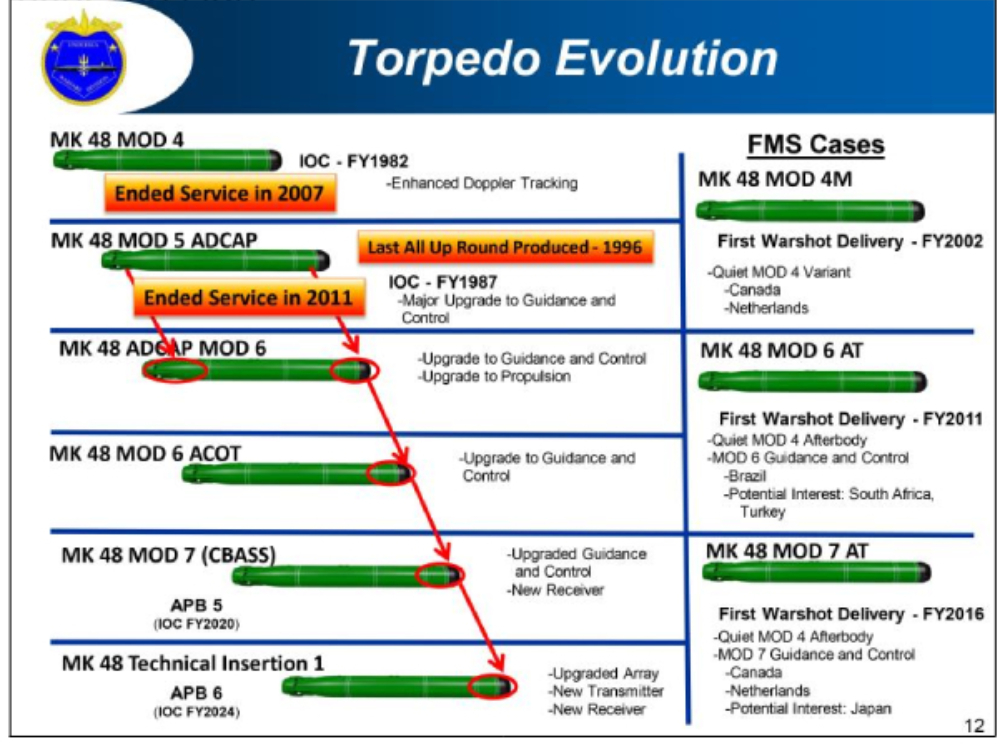
Then, of course, our original unmanned system with attitude is the ADCAP (Advanced Capability Torpedo), so I just wanted to give you a quick update that we have restarted the ADCAP production line. We also have it on a similar upgrade system as our APB model. It is an APB model. The numbers are a little bit different. So we’ve brought it back. We have it on the conveyor belt for improvements over time, and we’re very excited to start chipping away at this torpedo shortfall you’ve been hearing about for so long
Even more exciting is we’re starting to get into the world of anti-ship cruise missiles and a whole variety of missile family-type capability. In WESTPAC in particular, and actually in 5th Fleet as well, from Iran, they have anti-ship cruise missiles. They practice. They throw them up there quite a bit, and it drives an awful lot of our tactical thought out there.
I’m looking forward to paying that back to them and giving them something to think about. I think we’re on a good track there. It’s very immature at this point, but you’ll hear more about it as it comes along.
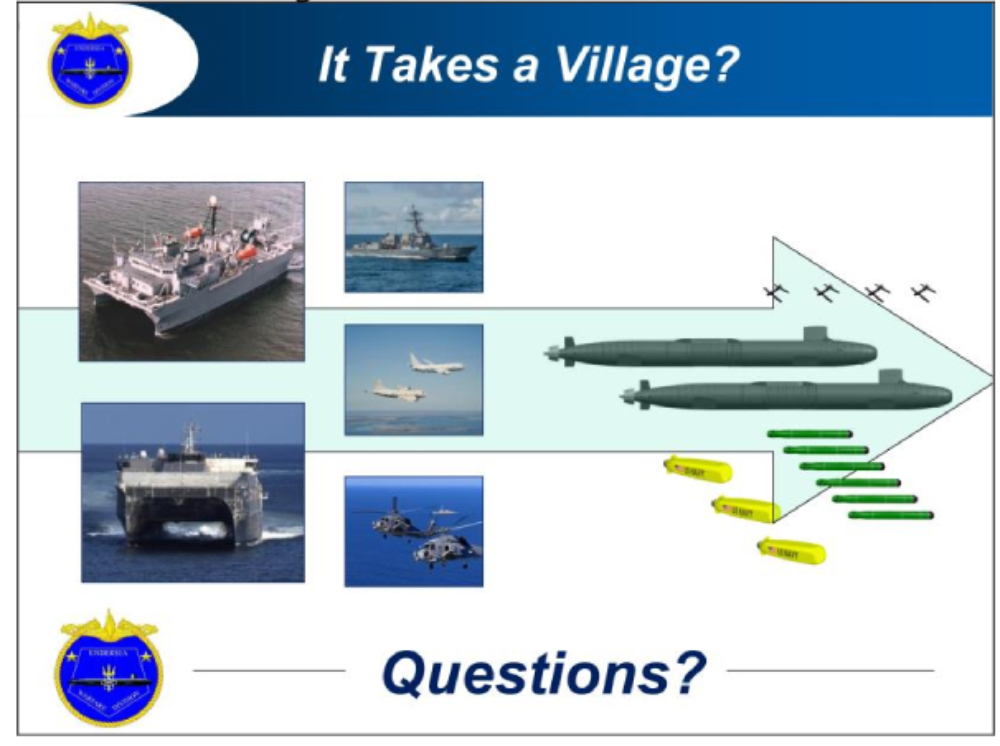
As I wrap up, this is my last slide. That’s kind of it for now. As I settle into this job I will be talking more and more about kill chains and the investments we need on those kill chains to make sure we shore everything up. But I will tell you right now, coming fresh from the fight, we’re on a good vector. Your boats are doing very well out there. The technology I see coming down the pike I think is very promising and we’re very excited to have it.

